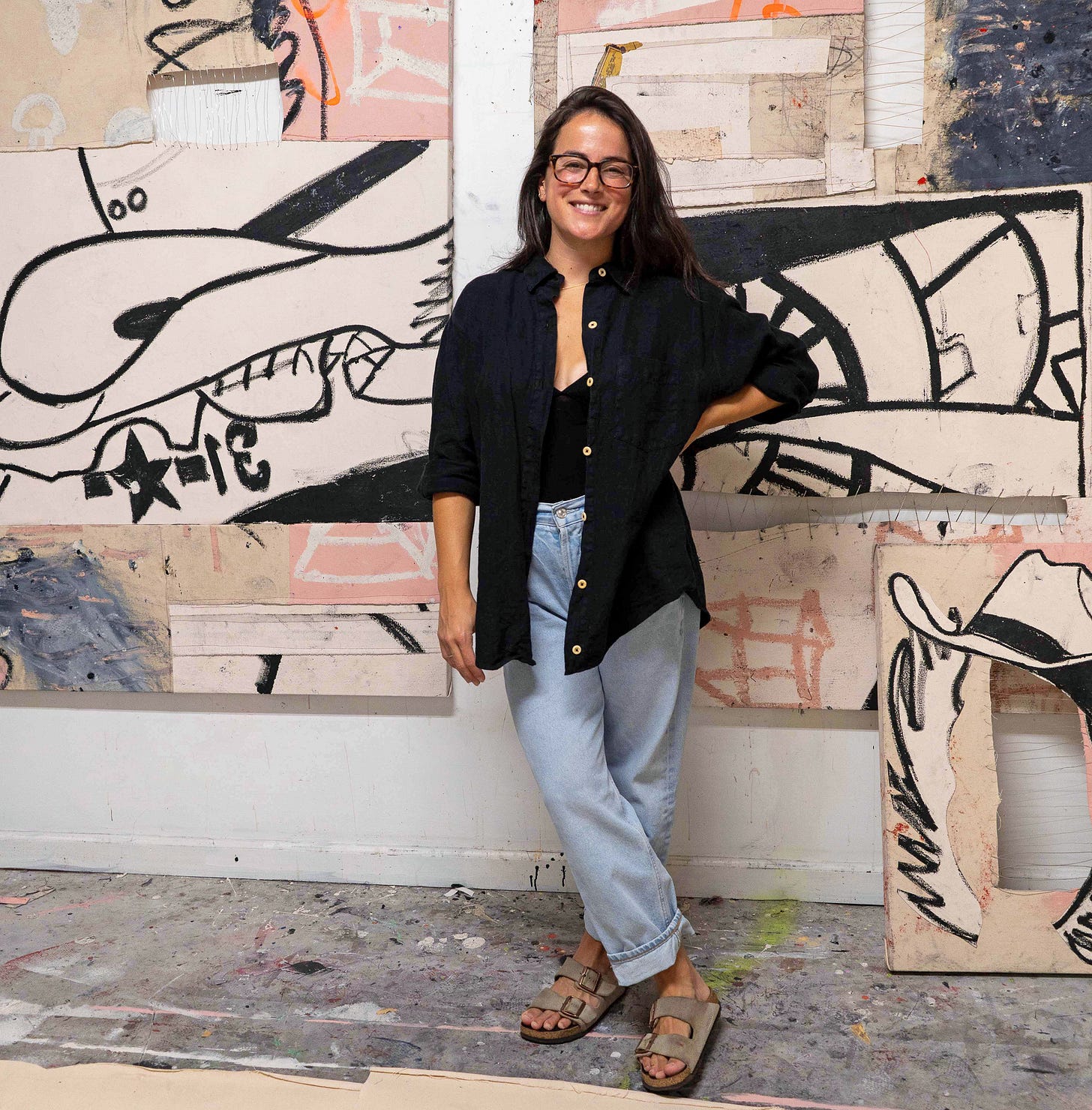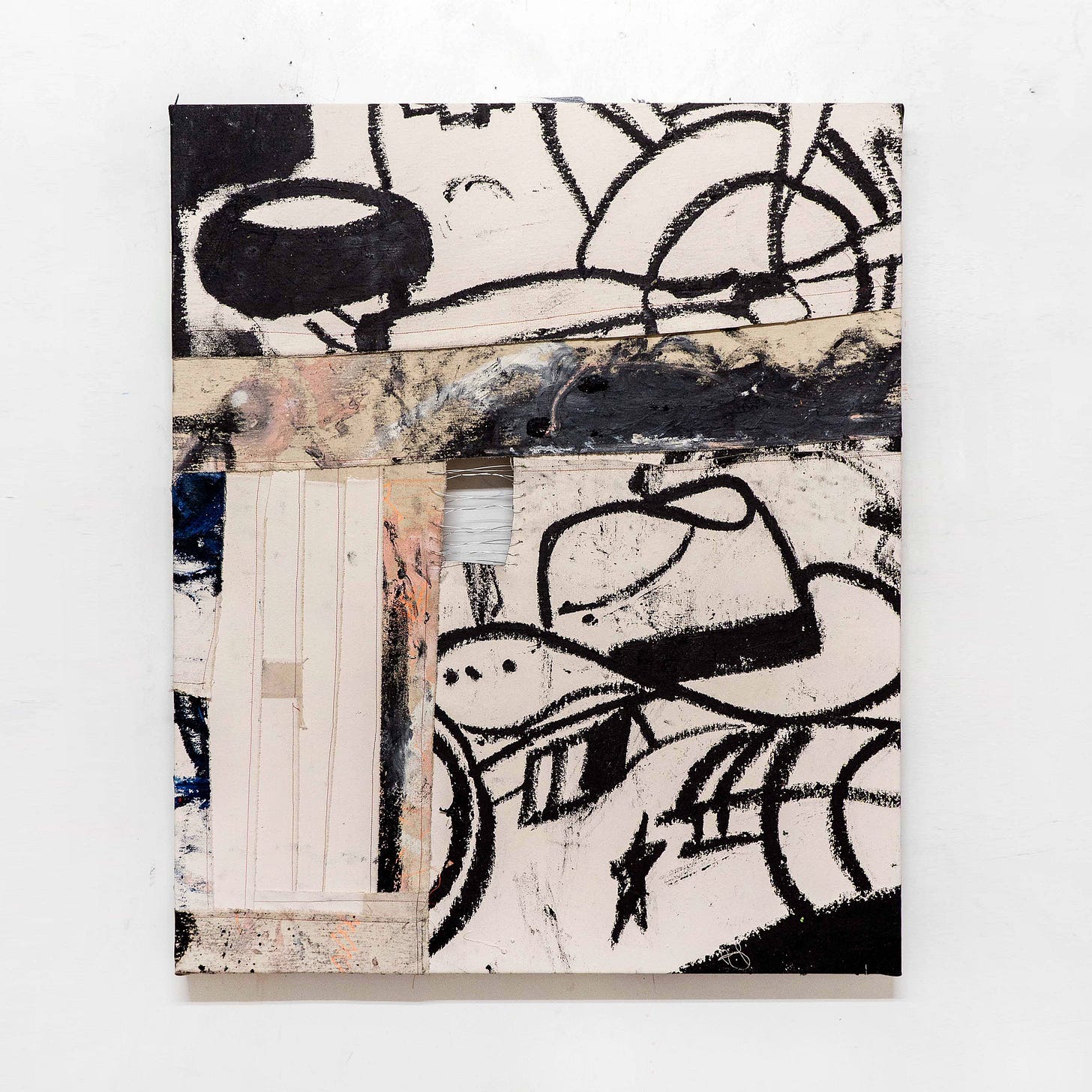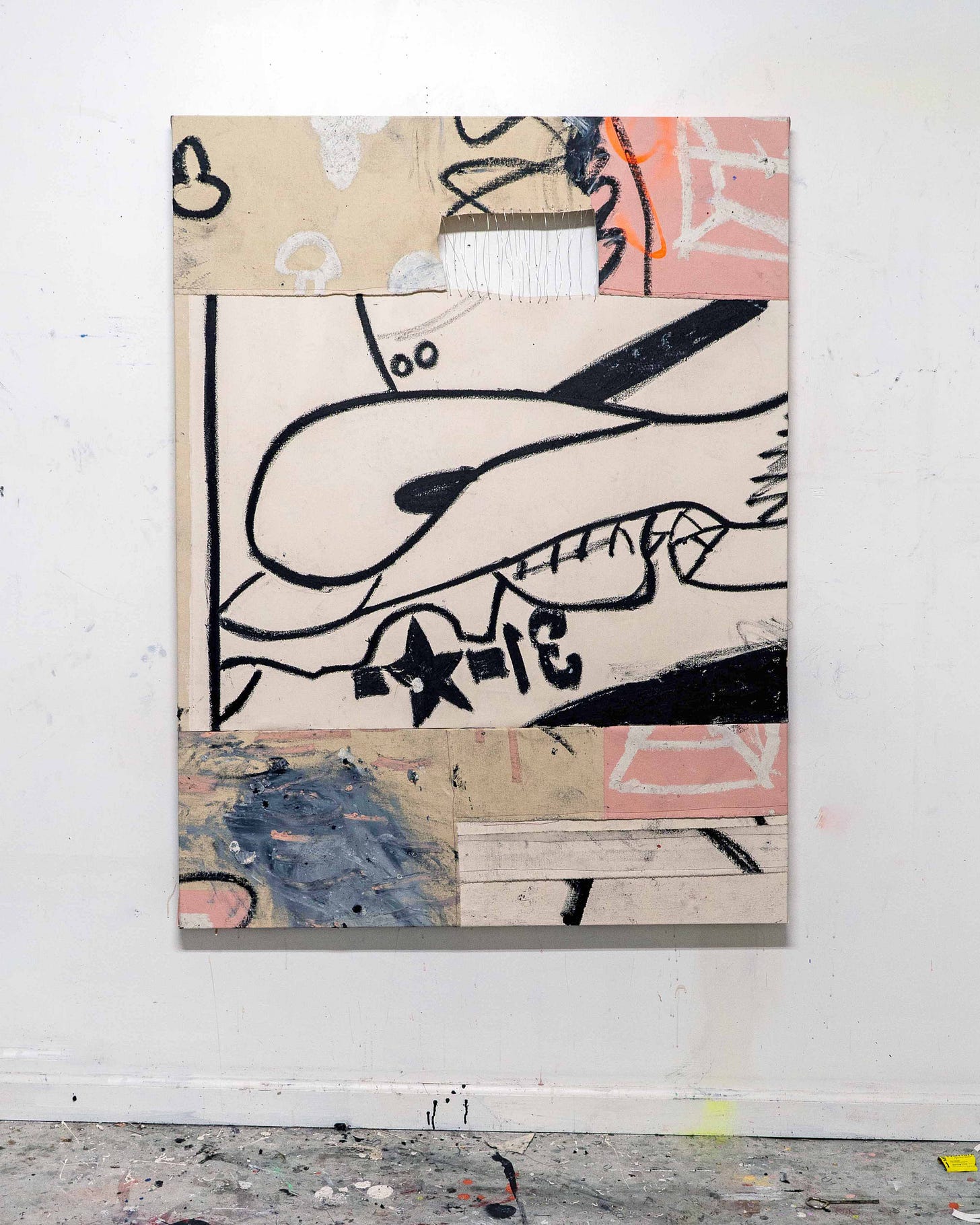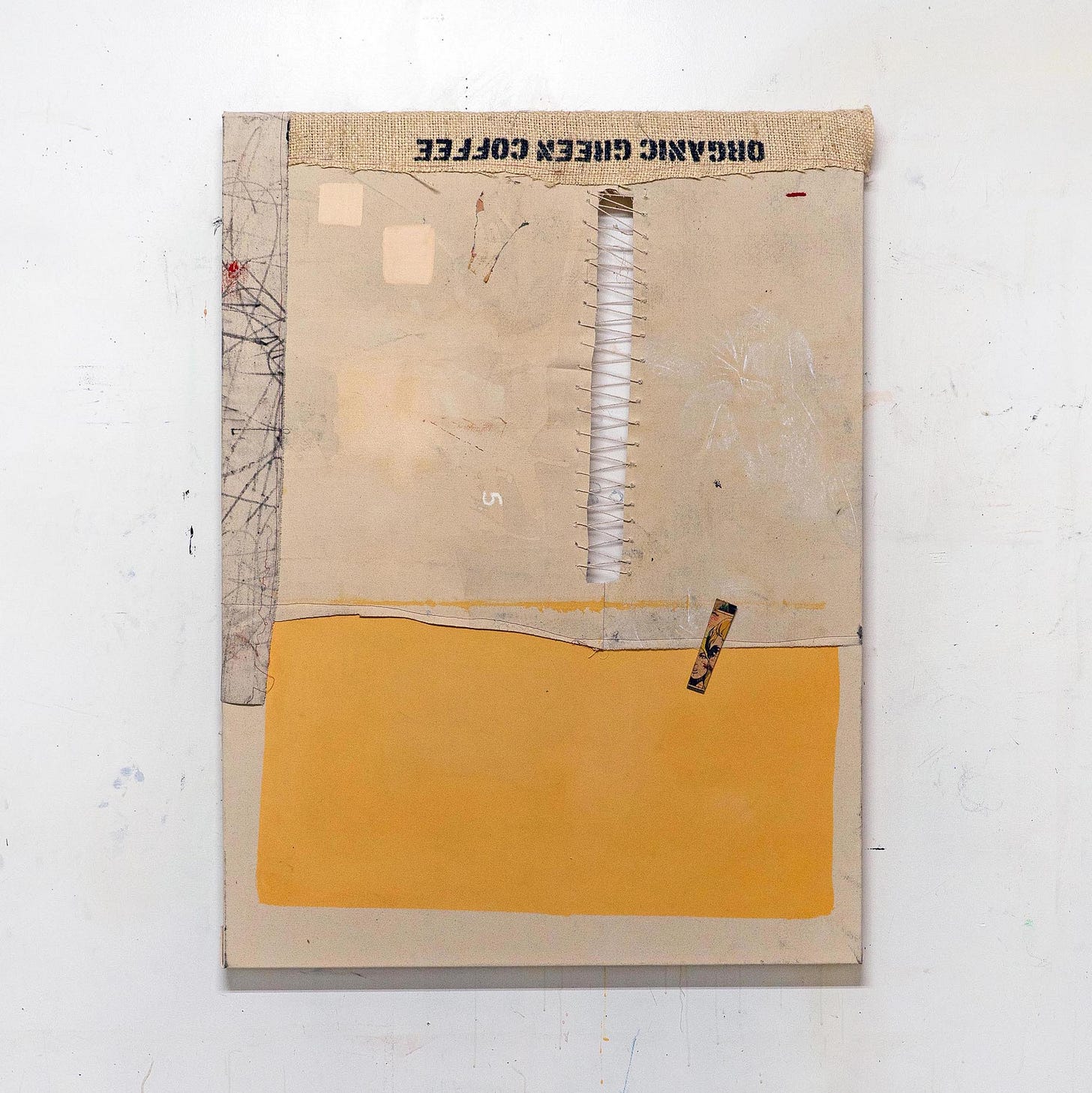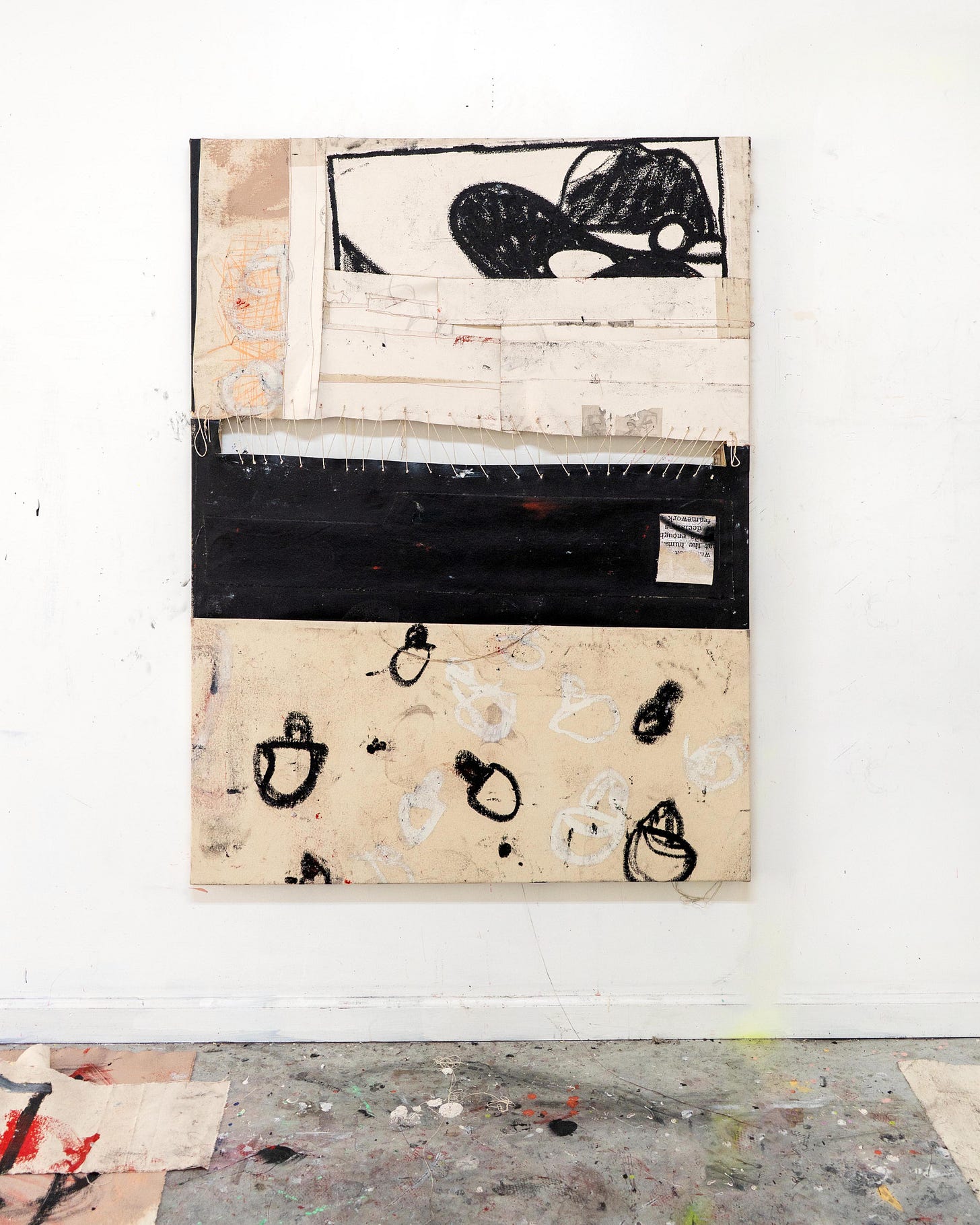The Playfully Fragmented Paintings of Merritt Spangler
I’m currently fascinated by artists who sew canvas fragments together. I’m especially intrigued by the idea of treating a painting as if it were a collage, where instead of paper and glue, artists use canvas and thread. Who says a painting has to be a single piece of canvas stretched on a frame anyway?
One such artist who caught my attention was Merritt Spangler. Her paintings contain fragments of hand-drawn cowboy imagery - hats, boots, etc. - sewn together with scraps of raw canvas featuring intermittent painterly gestures. The pieces are fittingly rugged, like they’ve been dragged through a dusty Texas canyon. They’re suggestive without being too literal, Merritt’s eye for wonderful abstract compositions giving enough space for you to dream and enjoy the various sections. I love how these separate slices of canvas aren’t neatly threaded together to form a perfect geometric composition. They’re more expressive, lassoed together in a charmingly slapdash way.
I reached out to Merritt - an artist who splits her time between Lake Tahoe, California and the Blue Ridge Mountains of North Carolina - on the eve of her solo show ‘Reckless Abandon’ at Shit Art Club in LA. I sensed we might have some things in common (namely our disinterest in perfectionism and our embracing of flaws). I also selfishly wanted to learn how she stitches her wonderfully fractured canvases together.
Hey Merritt. Firstly, can you tell me about the influence of cowboys in your work? Is there a personal connection?
There’s definitely a personal connection to cowboy hats (and I would emphasise the word hat) dating back to my childhood in Texas. I spent the majority of my earliest years of life living in red cowboy boots with the Texas Longhorn symbol on them. I’d walk around in my boots chasing after my toy airplane that would pretend to take off. When the engine roared from its speaker, as the nose tipped up, I would start to cry. I was so worried the plane would jet off into the sky without me that I would sleep with it every night. With that said, there is a deep personal connection to my formative years in the American South/Southwest where cowboy attire is prominent.
While I recognise the complicated past involving cowboys in American history, they do represent common American values in our society. By that I mean the heavy emphasis on independence and self-reliance you find across American culture. This is something I’ve been reflecting on since starting these paintings.
I’m curious how a piece comes together for you; do you work on a giant canvas on the floor, then cut it up and reassemble the parts?
I work on huge stretches of canvas, usually on the floor, which makes me feel more grounded in the process (no pun intended). Even if I’ve worked with oil, I almost immediately rip the canvas into pieces without much deliberation. This allows me to detach from any particular mark I’m immediately drawn to. I let the pieces of canvas lie on the studio floor for weeks, months, or sometimes years, collecting what I like to refer to as 'character.' After a while, I match the pieces together like a puzzle.
There is influence from the Japanese philosophy of kintsugi that can be found across most of my work. The concept is to embrace flaws and imperfections while valuing (and rebuilding) marks of wear and tear. In fact, it almost suggests highlighting the imperfections and accepting change. There are a few Japanese philosophies like this rooted in Zen Buddhism that have had a profound impact on both my art practice and my approach to life in general.
I’ve only just started sewing canvases together myself so I’m curious about your methods and what you love about it.
This is so funny, but I actually loathe sewing and I’m quite terrible at it. Ha! I do the yarn and wire in my work by hand, but for the actual sewing, I use a machine. Unfortunately, my mind and creative process work in such a way that it is absolutely necessary. I’ve come to love how bad I am at sewing, though. I decided a while back that all I really need is for the work to stay together. Perfection is something that does not interest me. I think it was the dancer Martha Graham who referred to perfection as ‘fatally uninteresting,’ and I would agree.
You’ll notice if you look closely that the thread often doesn’t run in a straight line. I don’t really care for straight lines because they are not a natural phenomenon (except maybe in physics?), and there is thread stringing out all over the place that I believe adds to the aesthetic. That statement is, of course, a contradiction because there are lines in my work elsewhere, but contradiction is good because it creates tension in the work that we can reflect on. Regardless, it would be easy to look at the work and say, “That is an unskilled craftsman,” and to some degree, you might be right. However, forcing a viewer to sit with the uncomfortable feeling of facing flaws in something expected to be perfect is both ironic and thought-provoking for me.
This acceptance of my poor sewing skills is what led me to the work I’ve been creating lately. When you don’t sew in a straight line, the canvas doesn’t crease properly, so rather than trying to create shallow perfection, I chose to emphasize it by cutting a hole where the imperfection once was. It is in the acceptance of flaws where something really special can be found if you’re willing to challenge it.
I like the way you sometimes leave a hole and have thread stitched across it like it’s lace top or skin that’s been pulled. It seems like that is also suggestive of something within the cowboy culture?
I originally started filling the holes with guitar strings and later moved onto other materials. Less than a year ago, my mother was diagnosed with ALS, a fatal neurodegenerative disease, and her first symptom was her inability to play a barre chord. Much of what I have said so far belies the fact that these recent works were created from a place of pure anticipatory grief, stemming from living with and caring for someone who is slowly slipping away. Her progression with ALS has been more rapid than most, and witnessing what has been taken from her has profoundly impacted my work. She had been playing guitar since she was a child, and it was a passion that allowed her to feel free from life’s tribulations. Her struggle with this disease, contrasted with the caged open holes in my paintings, highlights the reality that the very things that grant us freedom can be taken away in an instant.
In a broader sense, I believe the holes themselves could signify even more, from missing aspects of a story we believe to be true, to absence and the potential for renewal, to enduring incredible loss. For me, they highlight the void left in my heart and the profound loss I’ve personally experienced over the past year as my life has changed considerably.
I like that the drawing elements are fragmented and not too. How do you feel about walking that line between abstraction and representation?
Abstraction is a mental exercise, and I like using both sides of my brain when I paint. Reality bores me, and at times, figuration feels too much like reality. The only reason I've walked the line between the two recently was to get from point A to point B. I knew I had a goal of creating work that had perceived figuration within it, but I wasn't quite sure how to get there. I was also quite adamant about the image I wanted to deconstruct, and I think this recent work is just the beginning of a long exploration.
Do you think your work reveals anything about your personality?
If you’re being wildly authentic, I think it’s impossible to separate the art from the artist. I understand why we might want to separate the two when analyzing work, but authenticity is crucial in making art. That said, my work certainly reveals aspects of my personality. Lately, it probably reflects the manic state I occasionally enter due to the highly stressful environment I’m living in. Conversely, my more minimal work showcases aspects of my personality that I use to counterbalance stress and reground myself in philosophies like Zen Buddhism. Another artist recently described my work as having a softness and vulnerability that made it approachable. I hope my friends would read that and say, “Yes, that sounds like Merritt.”
Follow Merritt on Instagram: @merritt.spangler
Things on Our Radar This Week
Merritt’s solo show in LA at Shit Art Club
Berni Puig’s solo show at Alzueta Gallery in Girona, Spain
Sad news: VITRINE is closing all its galleries this month due to resources, staffing and the usual challenges faced by galleries
On a related note, what will the new Labour government mean for the arts in the UK?
A big new modern art gallery is opening in Milan after 50 years of delays
Thanks for reading, see you next time!
Oliver & Kezia xx
Palette Talk is free and we hope to grow with your support. If you’ve enjoyed reading, drop us a donation via PayPal…




